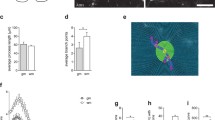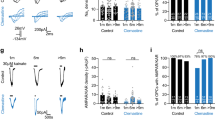Abstract
In the last years, regional differences have been reported between the brain and spinal cord oligodendrocytes, which should be considered when designing therapeutic strategies for myelin repair. Promising targets to achieve myelin restoration are the different components of the endocannabinoid system (ECS) that modulate oligodendrocyte biology, but almost all studies have been focused on brain-derived cells. Therefore, we compared the ECS between the spinal cord and cerebral cortex-derived oligodendrocyte precursor cells (OPCs) and mature oligodendrocytes (OLs). Cells from both regions express synthesizing and degrading enzymes for the endocannabinoid 2-arachidonoylglycerol, and degrading enzymes increase with maturation, more notably in the spinal cord (monoglyceride lipase-MGLL, alpha/beta hydrolase domain-containing 6-ABHD6, and alpha/beta hydrolase domain-containing 12-ABHD12). In addition, spinal cord OPCs express higher levels of the synthesizing enzymes diacylglycerol lipases alpha (DAGLA) and beta (DAGLB) than cortical ones, DAGLA reaching statistical significance. Cells from both the cortex and spinal cord express low levels of NAEs synthesizing enzymes, except for the glycerophosphodiester phosphodiesterase 1 (GDE-1) but high levels of the degrading enzyme fatty acid amidohydrolase (FAAH) that increases with maturation. Finally, cells from both regions show similar levels of CB1 receptor and GPR55, but spinal cord-derived cells show significantly higher levels of transient receptor potential cation channel V1 (TRPV1) and CB2. Overall, our results show that the majority of the ECS components could be targeted in OPCs and OLs from both the spinal cord and brain, but regional heterogeneity has to be considered for DAGLA, MGLL, ABHD6, ABHD12, GDE1, CB2, or TRPV1.







Similar content being viewed by others
References
del Río-Hortega P (1921) Estudios sobre la neuroglía. La glía de escasas radiaciones (oligodendroglía). Bol R Soc Esp Hist Nat XXI:63–92
van Tilborg E, de Theije CGM, van Hal M et al (2018) Origin and dynamics of oligodendrocytes in the developing brain: Implications for perinatal white matter injury. Glia 66(2):221–238
Chong SYC, Chan JR (2010) Tapping into the glial reservoir: cells committed to remaining uncommitted. J Cell Biol 188:305–312
Stadelmann C, Timmler S, Barrantes-Freer A, Simons M (2019) Myelin in the central nervous system: structure, function, and pathology. Physiol Rev 99:1381–1431. https://doi.org/10.1152/physrev.00031.2018
Pukos N, Goodus MT, Sahinkaya FR, McTigue DM (2019) Myelin status and oligodendrocyte lineage cells over time after spinal cord injury: what do we know and what still needs to be unwrapped? Glia. 67:2178–2202. https://doi.org/10.1002/glia.23702
Foerster S, Hill MFE, Franklin RJM (2019) Diversity in the oligodendrocyte lineage: plasticity or heterogeneity? Glia 67(10):1797–1805
Horiuchi M, Suzuki-Horiuchi Y, Akiyama T, Itoh A, Pleasure D, Carstens E, Itoh T (2017) Differing intrinsic biological properties between forebrain and spinal oligodendroglial lineage cells. J Neurochem 142:378–391. https://doi.org/10.1111/jnc.14074
Bechler ME, Byrne L, Ffrench-Constant C (2015) CNS myelin sheath lengths are an intrinsic property of oligodendrocytes. Curr Biol 25:2411–2416. https://doi.org/10.1016/j.cub.2015.07.056
Spitzer SO, Sitnikov S, Kamen Y, Evans KA, Kronenberg-Versteeg D, Dietmann S, de Faria O Jr, Agathou S et al (2019) Oligodendrocyte progenitor cells become regionally diverse and heterogeneous with age. Neuron. 101:459–471.e5. https://doi.org/10.1016/j.neuron.2018.12.020
Ibarrola N, Rodríguez-Peña A (1997) Hypothyroidism coordinately and transiently affects myelin protein gene expression in most rat brain regions during postnatal development. Brain Res 752:285–293. https://doi.org/10.1016/S0006-8993(96)01480-1
Power J, Mayer-Pröschel M, Smith J, Noble M (2002) Oligodendrocyte precursor cells from different brain regions express divergent properties consistent with the differing time courses of myelination in these regions. Dev Biol 245:362–375. https://doi.org/10.1006/dbio.2002.0610
Marques S, Zeisel A, Codeluppi S et al (2016) Oligodendrocyte heterogeneity in the mouse juvenile and adult central nervous system. Science (80- ). https://doi.org/10.1126/science.aaf6463
Marques S, van Bruggen D, Vanichkina DP, Floriddia EM, Munguba H, Väremo L, Giacomello S, Falcão AM et al (2018) Transcriptional convergence of oligodendrocyte lineage progenitors during development. Dev Cell 46:504–517.e7. https://doi.org/10.1016/j.devcel.2018.07.005
Pang Y, Zheng B, Kimberly SL, Cai Z, Rhodes PG, Lin RCS (2012) Neuron-oligodendrocyte myelination co-culture derived from embryonic rat spinal cord and cerebral cortex. Brain Behav 2:53–67. https://doi.org/10.1002/brb3.33
Gomez O, Arevalo-Martin A, Garcia-Ovejero D, Ortega-Gutierrez S, Cisneros JA, Almazan G, Sánchez-Rodriguez MA, Molina-Holgado F et al (2010) The constitutive production of the endocannabinoid 2-arachidonoylglycerol participates in oligodendrocyte differentiation. Glia 58:1913–1927. https://doi.org/10.1002/glia.21061
Ilyasov AA, Milligan CE, Pharr EP, Howlett AC (2018) The Endocannabinoid system and oligodendrocytes in health and disease. Front Neurosci 12. https://doi.org/10.3389/fnins.2018.00733
Molina-Holgado F, Molina-Holgado E, Guaza C (1998) The endogenous cannabinoid anandamide potentiates interleukin-6 production by astrocytes infected with Theiler’s murine encephalomyelitis virus by a receptor-mediated pathway. FEBS Lett 433:139–142
Arevalo-Martin A, Garcia-Ovejero D, Rubio-Araiz A et al (2007) Cannabinoids modulate Olig2 and polysialylated neural cell adhesion molecule expression in the subventricular zone of post-natal rats through cannabinoid receptor 1 and cannabinoid receptor 2. Eur J Neurosci 26:1548–1559. https://doi.org/10.1111/j.1460-9568.2007.05782.x
Arevalo-Martin A, Molina-Holgado E, Garcia-Ovejero D (2016) Cannabinoids to treat spinal cord injury. Prog Neuro-Psychopharmacol Biol Psychiatry 64:190–199. https://doi.org/10.1016/j.pnpbp.2015.03.008
Molina-Holgado E, Vela JM, Arevalo-Martin A et al (2002) Cannabinoids promote oligodendrocyte progenitor survival: Involvement of cannabinoid receptors and phosphatidylinositol-3 kinase/Akt signaling. J Neurosci 22:9742–9753
Sanchez-Rodriguez MA, Gomez O, Esteban PF, Garcia-Ovejero D, Molina-Holgado E (2018) The endocannabinoid 2-arachidonoylglycerol regulates oligodendrocyte progenitor cell migration. Biochem Pharmacol 157:180–188. https://doi.org/10.1016/j.bcp.2018.09.006
Mato S, Alberdi E, Ledent C, Watanabe M, Matute C (2009) CB 1 cannabinoid receptor-dependent and -independent inhibition of depolarization-induced calcium influx in oligodendrocytes. Glia. 57:295–306. https://doi.org/10.1002/glia.20757
Bernal-Chico A, Canedo M, Manterola A, Victoria Sánchez-Gómez M, Pérez-Samartín A, Rodríguez-Puertas R, Matute C, Mato S (2015) Blockade of monoacylglycerol lipase inhibits oligodendrocyte excitotoxicity and prevents demyelination in vivo. Glia. 63:163–176. https://doi.org/10.1002/glia.22742
Mechoulam R, Parker LA (2013) The endocannabinoid system and the brain. Annu Rev Psychol 64:21–47. https://doi.org/10.1146/annurev-psych-113011-143739
Savinainen JR, Saario SM, Laitinen JT (2012) The serine hydrolases MAGL, ABHD6 and ABHD12 as guardians of 2-arachidonoylglycerol signalling through cannabinoid receptors. Acta Physiol 204:267–276
Baggelaar MP, Maccarrone M, van der Stelt M (2018) 2-Arachidonoylglycerol: a signaling lipid with manifold actions in the brain. Prog Lipid Res 71:1–17
Irving A, Abdulrazzaq G, Chan SLF et al (2017) Cannabinoid receptor-related orphan G protein-coupled receptors. In: Advances in Pharmacology
Pertwee RG, Howlett AC, Abood ME, Alexander SPH, di Marzo V, Elphick MR, Greasley PJ, Hansen HS et al (2010) International Union of Basic and Clinical Pharmacology. LXXIX. Cannabinoid receptors and their ligands: beyond CB(1) and CB(2). Pharmacol Rev 62:588–631. https://doi.org/10.1124/pr.110.00300462/4/588
Di Marzo V (2018) New approaches and challenges to targeting the endocannabinoid system. Nat Rev Drug Discov 17:688
Arevalo-Martin A, Vela JM, Molina-Holgado E et al (2003) Therapeutic action of cannabinoids in a murine model of multiple sclerosis. J Neurosci 23:2511–2516
Arevalo-Martin A, Molina-Holgado E, Guaza C (2012) A CB 1/CB 2 receptor agonist, WIN 55,212-2, exerts its therapeutic effect in a viral autoimmune model of multiple sclerosis by restoring self-tolerance to myelin. Neuropharmacology. 63:385–393. https://doi.org/10.1016/j.neuropharm.2012.04.012
Gomez O, Sanchez-Rodriguez MA, Ortega-Gutierrez S, Vazquez-Villa H, Guaza C, Molina-Holgado F, Molina-Holgado E (2015) A basal tone of 2-arachidonoylglycerol contributes to early oligodendrocyte progenitor proliferation by activating phosphatidylinositol 3-kinase (PI3K)/AKT and the mammalian target of rapamycin (MTOR) pathways. J NeuroImmune Pharmacol 10:309–317. https://doi.org/10.1007/s11481-015-9609-x
Molina-Holgado F, Rubio-Araiz A, García-Ovejero D et al (2007) CB2 cannabinoid receptors promote mouse neural stem cell proliferation. Eur J Neurosci 25:629–634. https://doi.org/10.1111/j.1460-9568.2007.05322.x
Pedraza CE, Monk R, Lei J, Hao Q, Macklin WB (2008) Production, characterization, and efficient transfection of highly pure oligodendrocyte precursor cultures from mouse embryonic neural progenitors. Glia. 56:1339–1352. https://doi.org/10.1002/glia.20702
R Development Core Team (2017) R: A language and environment for statistical computing. Vienna
Wobbrock JO, Findlater L, Gergle D, Higgins JJ (2011) The aligned rank transform for nonparametric factorial analyses using only ANOVA procedures. In: Conference on Human Factors in Computing Systems - Proceedings
Kay M, Wobbrock JO (2015) ARTool: aligned rank transform for nonparametric factorial ANOVAs. R J. https://doi.org/10.1145/1978942.1978963>.Depends
Hintze JL, Nelson RD (1998) Violin plots: a box plot-density trace synergism. Am Stat 52:181–184. https://doi.org/10.1080/00031305.1998.10480559
Brown SM, Wager-Miller J, Mackie K (2002) Cloning and molecular characterization of the rat CB2 cannabinoid receptor. Biochim Biophys Acta Gene Struct Expr 1576:255–264. https://doi.org/10.1016/S0167-4781(02)00341-X
Griffin G, Tao Q, Abood ME (2000) Cloning and pharmacological characterization of the rat CB(2) cannabinoid receptor. J Pharmacol Exp Ther 292:886–894
Liu QR, Pan CH, Hishimoto A, Li CY, Xi ZX, Llorente-Berzal A, Viveros MP, Ishiguro H et al (2009) Species differences in cannabinoid receptor 2 (CNR2 gene): identification of novel human and rodent CB2 isoforms, differential tissue expression and regulation by cannabinoid receptor ligands. Genes Brain Behav 8:519–530. https://doi.org/10.1111/j.1601-183X.2009.00498.x
Schott JT, Kirby LA, Calabresi PA, Baxi EG (2016) Preparation of rat oligodendrocyte progenitor cultures and quantification of oligodendrogenesis using dual-infrared fluorescence scanning. J Vis Exp. https://doi.org/10.3791/53764
Dincman TA, Beare JE, Ohri SS, Whittemore SR (2012) Isolation of cortical mouse oligodendrocyte precursor cells. J Neurosci Methods 209:219–226. https://doi.org/10.1016/j.jneumeth.2012.06.017
Yang J, Cheng X, Shen J, Xie B, Zhao X, Zhang Z, Cao Q, Shen Y et al (2016) A novel approach for amplification and purification of mouse oligodendrocyte progenitor cells. Front Cell Neurosci 10. https://doi.org/10.3389/fncel.2016.00203
Barres BA, Hart IK, Coles HSR, Burne JF, Voyvodic JT, Richardson WD, Raff MC (1992) Cell death and control of cell survival in the oligodendrocyte lineage. Cell. 70:31–46. https://doi.org/10.1016/0092-8674(92)90531-G
Manterola A, Bernal-Chico A, Cipriani R, Canedo-Antelo M, Moreno-García Á, Martín-Fontecha M, Pérez-Cerdá F, Sánchez-Gómez MV et al (2018) Deregulation of the endocannabinoid system and therapeutic potential of ABHD6 blockade in the cuprizone model of demyelination. Biochem Pharmacol 157:189–201. https://doi.org/10.1016/j.bcp.2018.07.042
Gonzalez-Reyes LE, Ladas TP, Chiang CC, Durand DM (2013) TRPV1 antagonist capsazepine suppresses 4-AP-induced epileptiform activity in vitro and electrographic seizures in vivo. Exp Neurol 250:321–332. https://doi.org/10.1016/j.expneurol.2013.10.010
Yamazaki Y, Hozumi Y, Kaneko K, Sugihara T, Fujii S, Goto K, Kato H (2007) Modulatory effects of oligodendrocytes on the conduction velocity of action potentials along axons in the alveus of the rat hippocampal CA1 region. Neuron Glia Biol 3:325–334. https://doi.org/10.1017/S1740925X08000070
Acknowledgments
We thank Drs. Jose Ángel Rodriguez Alfaro and Javier Mazarío (Microscopy Facilities at the Hospital Nacional de Paraplejicos) for assistance with image acquisition and processing and María del Mar del Cerro for her outstanding technical assistance in the laboratory.
Funding
This work was funded by the Ministry of Science, Innovation, and Universities of Spain, Grant ID SAF2015-69927 (co-funded by FEDER-European Union) to EMH and DGO.
Author information
Authors and Affiliations
Corresponding authors
Ethics declarations
Conflict of Interest
The authors declare that they have no conflicts of interest.
Ethics Approval
Experimental procedures were approved by the Ethical Committee for Animal Research at the National Paraplegics Hospital (CEEA).
Consent to Participate
Not applicable.
Consent for Publication
Not applicable.
Additional information
Publisher’s Note
Springer Nature remains neutral with regard to jurisdictional claims in published maps and institutional affiliations.
D. Garcia-Ovejero and E. Molina-Holgado should be considered joint senior and corresponding authors.
Electronic Supplementary Material
Supplementary Fig. 1
High yield cultures are required to obtain enough number of oligodendrocyte cells without using high number of animals. (A) A low number of cells are recovered after trypsin digestion of a single cerebral cortex or spinal cord from a P0 neonatal rat pup. Specially, ten times less cells are obtained from a single spinal cord than from a single cerebral cortex of one animal for the initial mixed cell culture in the classical protocol (PNG 111 kb)
Supplementary Fig. 2
Myelination progress of dorsal root ganglion cells cocultured with spinal or cortical derived OPCs. (A, B) After 12 days of co-culture, MBP+ OLs (green) show ramified morphologies both in cortex and spinal derived cells, not fully enwrapping Neurofilament+ axons (red), except in occasional cells in spinal cord derived cultures (not shown). (C) After 19 days, occasional myelinating cells with several parallel processes enwrapping axons can be found in cortical derived OPCs, whereas at the same time point (19 days) these cells are frequently found in spinal cord derived cells (D). (E) High frequency of MBP+ myelinating cells similar to that found in spinal cord at 19 days can be found in cortical derived cells at later time points (27 days). Spinal cord derived OPC-DRG cocultures were not maintained beyond 19 days since extensive myelination was already assessed at that time point. Scale bars: 100 μm (JPEG 3861 kb)
Rights and permissions
About this article
Cite this article
Moreno-Luna, R., Esteban, P.F., Paniagua-Torija, B. et al. Heterogeneity of the Endocannabinoid System Between Cerebral Cortex and Spinal Cord Oligodendrocytes. Mol Neurobiol 58, 689–702 (2021). https://doi.org/10.1007/s12035-020-02148-1
Received:
Accepted:
Published:
Issue Date:
DOI: https://doi.org/10.1007/s12035-020-02148-1




